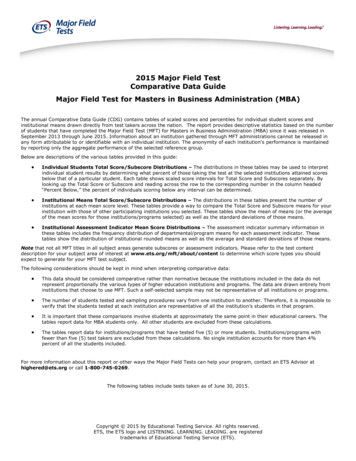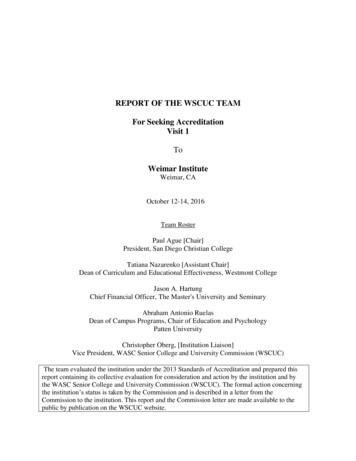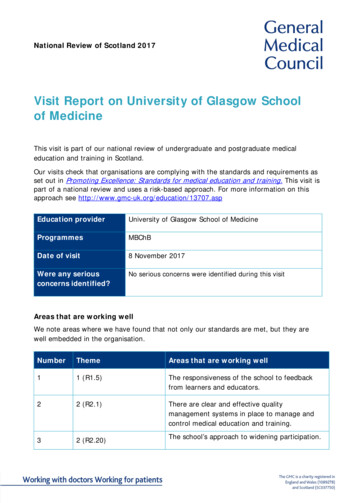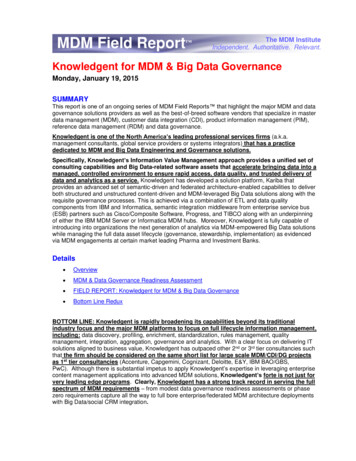
Transcription
LISTENING PROJECTField Visit ReportAfghanistanApril – May 2009
This document was developed as part of a collaborative learning project directed by CDA. It ispart of a collection of documents that should be considered initial and partial findings of theproject. These documents are written to allow for the identification of cross-cutting issues andthemes across a range of situations. Each case represents the views and perspectives of a varietyof people at the time when it was written.These documents do not represent a final product of the project. While these documents maybe cited, they remain working documents of a collaborative learning effort. Broadgeneralizations about the project’s findings cannot be made from a single case.CDA would like to acknowledge the generosity of the individuals and agencies involved indonating their time, experience and insights for these reports, and for their willingness to sharetheir experiences.Not all the documents written for any project have been made public. When people in the areawhere a report has been done have asked us to protect their anonymity and security, in deferenceto them and communities involved, we keep those documents private.2
Table of ContentsBackground on the Listening Project . 4The Listening Exercise in Afghanistan . 4Brief Note on the Context and History of International Assistance in Afghanistan . 5What People Said . 71.Appreciation for Assistance and Positive Changes . 74.Lack of Monitoring and the Importance of Presence. 142.Corruption . 103.The Influence of Power Structures . 135.6.7.8.9.External Pressures and Agendas . 16Community Consultations. 18Quality and Gaps in Assistance. 20Poor Quality . 20Piecemeal Assistance. 22Expectations . 23Aid not reaching remote areas . 2410.Relationships between Conflict and Insecurity and Aid Efforts . 25Dependency and Powerlessness. 27Differentiation among Implementers of Aid Efforts . 28Insider–Outsider Dynamics . 30Concluding Reflections from LP Team Facilitators . 313
Background on the Listening ProjectCDA Collaborative Learning Projects, with a number of colleagues in international and localnon-governmental organizations (NGOs), donors and other humanitarian and developmentagencies, has established the Listening Project to undertake a comprehensive and systematicexploration of the ideas and insights of people who live in societies that have been on therecipient side of international assistance efforts. The Listening Project seeks the reflections ofexperienced and thoughtful people who occupy a range of positions within recipient societies toassess the impact of aid efforts by various international actors. Those who work across borders inhumanitarian aid, development assistance, peace-building efforts, environmental conservation,and human rights work can learn a great deal by listening to the analyses and suggestions of localpeople as they reflect on the immediate effects and long-term impacts of such efforts.The Listening Teams are made up of staff from international and local aid agencies, withfacilitators from CDA. The teams do not use pre-established questionnaires or a rigid interviewprotocol. Rather, we tell people that, as individuals engaged in international assistance work, weare interested to hear from them how they perceived these efforts. We ask if they would bewilling to spend some time with us, and to share their opinions and ideas. In this way, weconverse about their issues of concern, without pre-determining specific topics.Many conversations are held with one or two individuals, but in some cases, larger groups formand what begins as small-group dialogues becomes, in effect, free-flowing group discussions. Inmost cases, conversations are not pre-arranged (except for appointments with governmentofficials and other key stakeholders). A Listening Team travels to a community and strikes up aconversation with whomever was available and willing to talk, speaking both to people who haveand have not received international assistance.Over a period of four years, the Listening Project has visited twenty locations, with Afghanistanbeing the 15th. The Project is gathering what we hear from people in all of these locations inorder to integrate these insights into future aid work and, thereby, to improve its effectiveness.A collaborative learning process such as the Listening Project depends entirely on the peoplewho took time to share their thoughts with us, and on the involvement and significantcontributions of all the participating agencies. Those staff and community members who wereinvolved in Afghanistan deserve great appreciation for their generous support, insights, anddedication.The Listening Exercise in AfghanistanThe Listening Project organized a ten-day listening exercise in Afghanistan in late April 2009,with generous support from the Afghan Ministry of Rural Rehabilitation and Development(MRRD) and the following international and local NGOs: Agence d’Aide à la CoopérationTechnique Et au Développement (ACTED), Afghan Aid, Aga Khan Trust for Culture, CatholicRelief Services (CRS), Concern, Sanayee Development Organization (SDO), Shuhada, and UNHabitat. The participating agencies provided invaluable logistical support and staff to participateon the Listening Teams. In total, twenty-two staff from these organizations took part in4
listening, and most of them were Afghan nationals, men and women, representing various ethnicbackgrounds and several provinces of the country. In addition, CDA provided three facilitatorswho traveled out to the provinces, took part in the conversations, and facilitated the analysis.Listening Teams visited neighborhoods in Kabul city and north of Kabul, and communities inand around Bamiyan and Badakhshan Provinces. These provinces were proposed by theparticipating agencies and selected in consultation with CDA based on where they had the moststaff to contribute to the listening effort. The Listening Project made an effort to organize fieldvisits in less secure areas of the country, however due to safety considerations and fewer staffavailable from organizations working there, the areas visited were all relatively stable andsecure. The Listening Project is aware of this limitation in the scope of this field visit report andwe acknowledge that the conversations contained herein represent only a small fraction of theopinions and experiences of the people in Afghanistan. We have captured a valuable snapshot ofsome perspectives and opinions on the cumulative effects of international assistance and haveadded these insights to the overall body of evidence gathered by the Listening Project. However,we do not attempt to draw broad conclusions from this visit. Subject to safety concerns andavailability of funding, we will continue to pursue opportunities to listen in other provinces ofthe country to supplement what people said in April 2009.In total, the Listening Teams in Afghanistan held 140 conversations with 300 people.Conversations involved men and women, youth and elderly people, people who have been directrecipients of international assistance and those who have not. Listening Teams met withrepresentatives of local municipalities, village and religious leaders, local NGOs and communitybased organizations, school personnel, university professors and students, medical personnel,farmers, shopkeepers, internally displaced people, and other randomly selected people.In addition to the listening conversations held in the provinces, Listening Project facilitatorsconducted a one and a half-day Feedback Session with government officials, representativesfrom the UN system and international and local NGOs, hosted by the MRRD. CDA facilitatorsshared the findings and analysis of what people have said in previous Listening Exercises(captured in Issues Papers available on the CDA website) and invited feedback and reflectionsfrom participants about their experiences in Afghanistan and other places. Some of theirfeedback is included in this report.Brief Note on the Context and History of International Assistance in AfghanistanAfter decades of war and interventions by outsiders, Afghanistan remains a highly fragmentedand fragile state characterized by insecurity, deep structural poverty and a divided society.During the Cold War, various political and military factions within Afghanistan receivedexternal assistance from the Soviet Union and the United States, much of it in the form ofmilitary aid and weapons, which continue to be used today. External military assistanceeffectively dried up after Soviet forces pulled out of the country in 1989, while the Taliban andwarlords sought control over large swaths of the country and its population. 1 In the 1990s, very1Smart Development in Practice: Field report from Afghanistan. Oxfam America, p.2 -afghanistan.pdf5
little external assistance other than humanitarian aid trickled into Afghanistan as it was ravagedby civil war, and a large number of international aid agencies and Afghan aid workers assistedmillions of refugees who fled to camps in Pakistan. Today, half of Afghanistan’s populationlives in absolute poverty, with over 2 million people lacking regular access to food, 70 % of thepopulation are illiterate and 40% of the people are unemployed. 2Following the US invasion and the retreat of the Taliban forces in 2002, the internationalcommunity pledged to support the security and reconstruction of Afghanistan. Currently 46countries provide over 100,000 troops to the International Security Assistance Force (ISAF).The United States, European Union, United Kingdom, Japan, and the World Bank are amongover 60 countries and international financial institutions contributing to reconstruction anddevelopment efforts. While the international community has pledged 25 billion to Afghanistansince 2001, it has only delivered 15 billion, and assistance for reconstruction and developmentremains just a fraction of international contributions. Oxfam International reports that the “USmilitary currently spends nearly 100 million a day in the country, some 36 billion a year. Yetthe average volume of international aid provided by all donors since 2001 is woefully inadequateat just 7 million per day.” 3National Solidarity Program (NSP), a program initiated by the Afghan-government and fundedby international donors, is widely recognized as a successful but under-funded rural developmentprogram. According to a recent policy brief by Center for a New American Security, “NSP isexemplary not simply in terms of the tangible services it has delivered to Afghanistan’spopulation; ‘owned’ by the Afghans and run with an emphasis on transparency, the NSP is oneof the few initiatives from Kabul to have generated significant goodwill among ruralcommunities. Furthermore, the NSP has achieved concrete successes at a price tag considerablylower than large-scale, Western-led initiatives.” 4Despite the massive injections of international assistance and security personnel, much of theinternational assistance has not been very effective due to endemic corruption, resurgent Talibanactivity and a thriving illicit economy which have also combined to undermine the influence ofthe national government. Insecurity, weak state capacity, poor infrastructure and deeplyingrained mistrust have created a difficult environment for aid agencies to operate. Over 1,200national and 301 international NGOs are currently registered in the country, 5 and many havebeen exposed to threats and extortion as they struggle to differentiate themselves from thesecurity agenda in an environment where the principle of “Do No Harm” has been repeatedlyviolated by non-humanitarian actors.2U.S. Aid to Afghanistan by the Numbers, Center for American 8/08/left behind.html3“Falling Short: Aid Effectiveness in Afghanistan” Report by
Field Visit Report . Afghanistan . April – May 2009 . 2 . This document was developed as part of a collaborative learning project directed by CDA. It is part of a collection of documents that .











